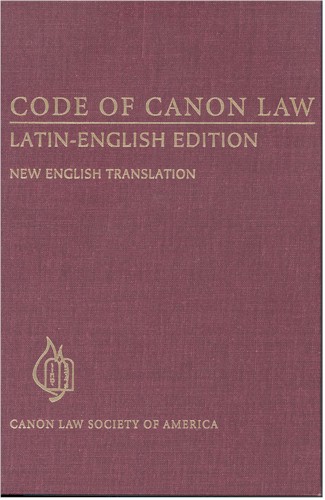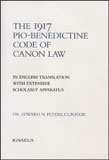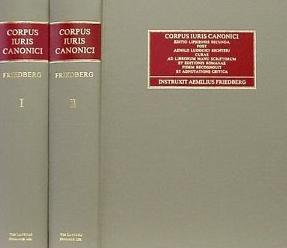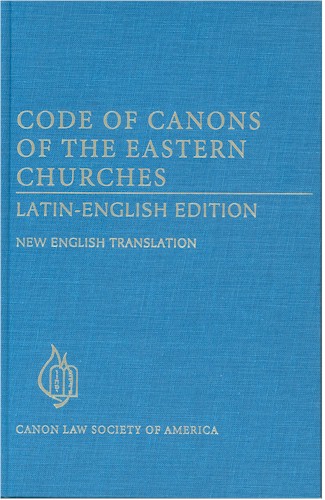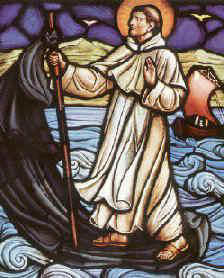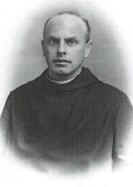|
To work for the proper implementation of canon law is to play an extraordinarily constructive role in continuing the redemptive mission of Christ. Pope John Paul II |
|
|
|
|
Resolution 1152 x 864 |
Updated 1 feb 2017 |
Ten Resources
Needed to Study the 1917 Code of Canon Law in English |
|
Overview |
When researching the 1917 Code in English, remember that many of the sources (fontes) listed in Gasparri's Latin footnotes are available in English, including all ecumenical councils (the two Schroeder translations are quite good), all papal encyclicals after 1740 (thanks in large part to Claudia Carlen, ihm), and even some parts of Gratian's Decretum (e.g., Hymans' translation of marriage canons.)
|
|
Law and texts |
1. Edward Peters, Curator, The
1917 or Pio-Benedictine Code of Canon Law in English Translation with Extensive
Scholarly Apparatus, (San Francisco: Ignatius Press, 2001), ISBN:
0-89870-831-0. Acceptable cite form: 1917 CIC [canon number] (Peters’
trans.). Notes: Comprehensive, faithful English translation of the entire
1917 Code and most supporting documents. Internally cross-referenced, and
completely correlated with both Canon Law Digest and the 1983 Code.
Features citations, by canon number or topic, to hundreds of English language
doctoral dissertations in canon law culled from the world’s pontifical and
Catholic faculties of canon law.
2. Canon Law Digest, vols.
I-X. Various publishers
and editors since 1933, currently supervised by the Canon Law Society of America
in Washington DC. English translations of hundreds of official documents,
dealing with canon law throughout its 65-year enforcement period, listed
canon-by-canon for distinct periods. The only weakness in the work, the lack of
a comprehensive index, is remedied by the Peters translation of the 1917 Code listed immediately above.
3. Canons and Decrees of the Council of Trent Various editions available. Needed to trace numerous doctrinal issues treated under the 1917 Code. The Council of Trent is very frequently referenced in 1917 Code footnotes. Cardinal Gasparri called the Council of Trent “an unsurpassed source of law in the Church.”
|
|
Commentaries
Both the original multi-volume Catholic Encyclopedia published just before the 1917 Code appeared, and the multi-volume New Catholic Encyclopedia published during the waning days of the 1917 Code, contain numerous entries on a wide variety of canonical topics. They are under-appreciated canonical research tool. |
4. T. Lincoln Bouscaren & Adam Ellis, Canon Law: A Text and Commentary, Various editions, (Bruce Publishing: Milwaukee, 1946/1966). Acceptable cite form: Bouscaren & Ellis, Canon Law [page]. This is the way two generations of North American canon lawyers learned the 1917 Code. Light only in procedures. Very reliable.
7. Stanislaus Woywod, A Practical Commentary on the
Code of Canon Law, published by Wagner of New
York in one- and two-volume formats beginning in 1925, later editions revised by Callistus Smith. Acceptable cite form:
Woywod, Practical Comm., [vol. no. & page]. Paraphrases of nearly all canons, with succinct commentary by a
highly regarded canon and civil lawyer. More scholarly than its
“handbookish” title would suggest.
8. Henry Ayrinhac wrote a series of six monographs covering most of the Pio-Benedictine Code.
|
|
|
Minor pan-textual commentaries in English would include:
Fernando Della Rocca (Italian layman, =), Manual of Canon Law (Bruce, 1959) 624 pp, Thatcher trans. of a work later published in Italian.
Matthew Ramstein (American Franciscan, 1897-1952), A Manual of Canon Law (Terminal, 1947) 768 pp.
|
|
Canonical Journals and Series in English
|
The Jurist, founded in 1941 at The Catholic University of America, is very important for English canonical research on the Pio-Benedictine Code. But see also The American Ecclesiastical Review, founded in 1890, for many excellent canon law articles amid the wide range of topics tackled therein, and (albeit less frequently) Homiletic and Pastoral Review and Review for Religious.
Of course, one would also want access to the Canon Law Studies doctoral dissertation series from CUA, with hundreds of canonical monographs beginning in 1916.
|
